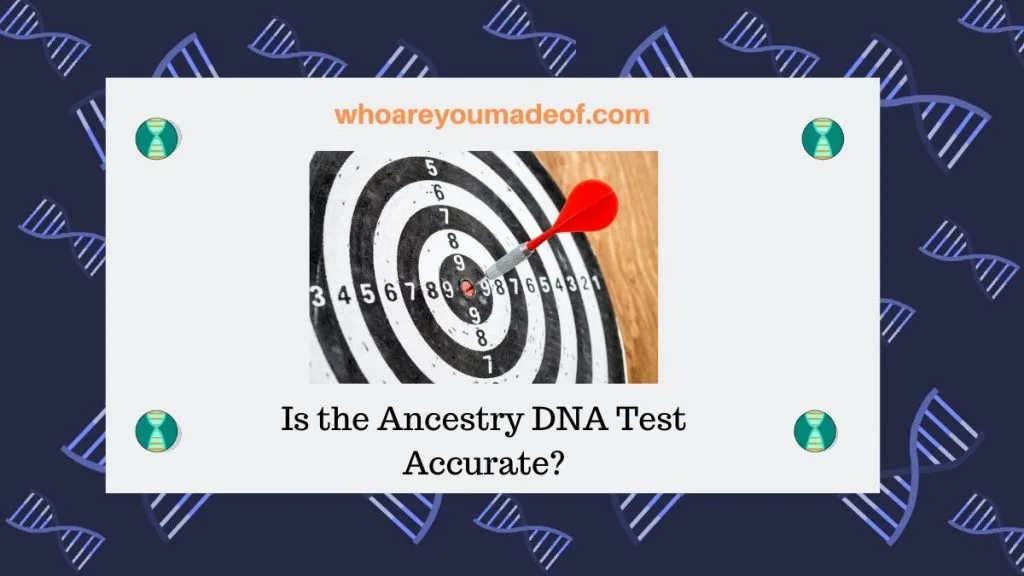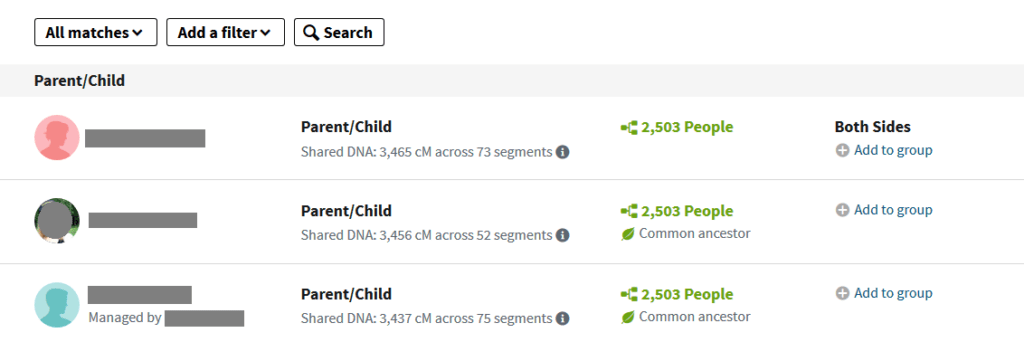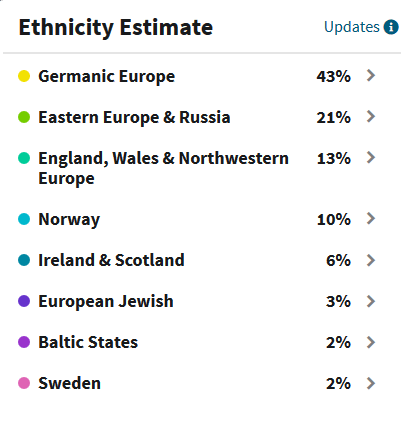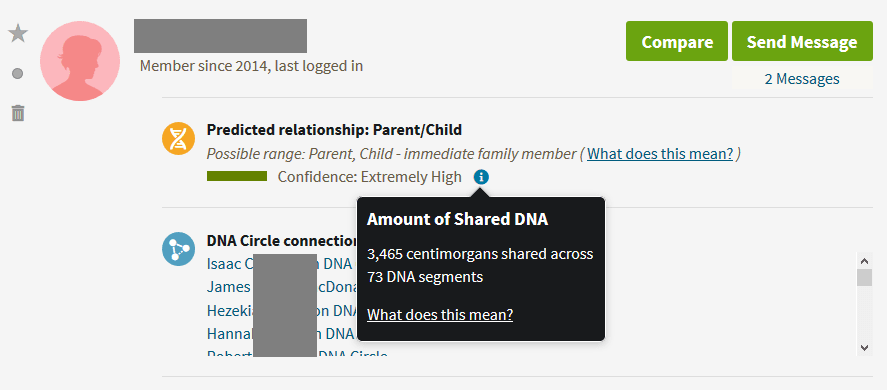Do you want to know if the Ancestry DNA test is accurate? In this post, find out whether your ethnicity estimate and DNA match results are always correct.
With all of the buzz around the topic of DNA testing, you have probably read lots of people come down on both sides of the question. Some insist that Ancestry DNA results aren't always accurate, while others promise that they are.
What's the truth?

Below, you will find out:
- What you need to know about understanding the accuracy of Ancestry DNA results
- How accurate Ancestry DNA ethnicity estimates are, and how they get your ethnicity
- Whether Ancestry DNA matches are accurate, and how they find your DNA matches
Plus, I'll show you an example of Ancestry DNA's accuracy from my own DNA results. How cool is that?
I tested with Ancestry about four years ago, and it has been the source of tons of fun and intrigue for me ever since. As someone with a keen interest in genealogy, it was very important to me to understand whether I could trust my DNA results.
Whether you have already tested and are wondering how accurate your results are, or are reading this post because you are thinking about testing, I hope your ancestry DNA experience is just as fulfilling as mine was.
How is the Ancestry DNA Test Accurate?
Ancestry DNA results are broken down into two main sections comprised of your ethnicity estimate and your DNA match list. In order to talk about the accuracy of Ancestry DNA, we really need to discuss the two main elements of results as two different topics.
The two main elements of the Ancestry DNA test are:
- Your DNA match list, which contains the names of people who have tested with Ancestry DNA and who are related to you
- Your ethnicity estimate, which contains a pie chart and list of percentages corresponding to regions all over the world that match your DNA
While there are other important features to Ancestry DNA, such as Ancestry DNA ThruLines, the DNA matches and the ethnicity estimate are the most important aspects of results.
How Ancestry DNA determines your ethnicity
One of the main reasons that many people choose to do the Ancestry DNA test is in order to find out their ethnicity. It's really fun to be able to share your ethnicity estimate with family members, and it is a great way to learn the basics about where your ancestors may have lived over the past several hundred years.
Ancestry is able to get your ethnicity estimate by creating unique regional DNA profiles using thousands of DNA samples from people all over the world whose families have lived in the same area for generations. Ancestry DNA then compares your individual profile to those regional profiles to give you an ethnicity estimate.
While it's not an exact science, it is the easiest way to get a glimpse into your family's history!
How Ancestry DNA finds DNA matches
When you submit your DNA sample, the Ancestry DNA laboratories use sensitive equipment in order to create your individual DNA profile. Afterwards, your profile is compared to those of all of the other Ancestry DNA users in order to find matching DNA segments.
Depending on the size and quantity of these matching segments, Ancestry can determine whether you are related and how close the relationship is.
Below is an image taken from my DNA match list. The top three matches are my oldest daughter, my mother, and my father. If I click on their names, I can see more details about our shared DNA.

Our DNA match lists can vary in size. Some people have several hundred genetic relatives, and others have tens of thousands. The number of DNA matches that you will have on your results will depend on how many of your genetic relatives have taken an Ancestry DNA test.
How accurate is Ancestry DNA ethnicity estimate?
Because ethnicity results as the most common reason that people become interesting in DNA testing, I'll start off here by showing you an example from my own ethnicity results.
I have a very well-researched, DNA verified family tree. Everyone has 16 great-great grandparents, and mine s come from the following regions of the world:
- 6 (37.5%) are from Germany and the Netherlands
- 4 (24%) are from Eastern Europe (Poland and Slovakia)
- 6 (37.5%) are from Ireland, Scotland, or England, or have ancestry primarily from those reasons
Before you look at my ethnicity estimate to compare it to where my ancestors were born, there are a few important things you should know.
First, ethnicity is not inherited evenly from our ancestors, and we don't inherit DNA from all of our ancestors. A child inherits about 50% of each of their parent's DNA, but there is 50% of each parent's DNA that doesn't get passed down each generation.
Our ancestors were more mobile than many people realize, and thus may not have been of the ethnicity that we might assume. They moved around a lot! For example, someone from Italy might have had significant contributions to their genome from surrounding regions.

What do you think?
My ethnicity estimate lines up pretty well with what I know to be true about my family tree. The only surprise for me is the 10% Norway on my results. I believe that I know a line of my family tree that deserves more scrutiny - perhaps I'll find a Norwegian ancestor there.
Everyone takes an Ancestry DNA test for different reasons. My husband and I decided to "gift" ourselves DNA tests for our birthdays one year, which happen to be less than one month apart.
Why did we want to test our DNA?
It was really for two reasons. First, because there were rumors in my family that we had a Native American ancestor and I was extremely curious about whether this was true or not.
The second reason is because my husband, who is Mexican, has red hairs in his beard when he lets it grow. I always teased him about his red-haired Spaniard great-great-great grandfather.
(Note: My husband was adopted when he was a small child and we had no idea if a red-haired Spanish great-great-great grandfather really existed. Do Spaniards even have red hair?)
The best part about the Ancestry DNA ethnicity estimate is that they are always trying to improve the science and technology behind the results. If Ancestry comes up with new research that might affect your DNA results, they will update your ethnicity estimate.
I've had my results updated a few times, and it has always been free.
I love free 🙂 Ancestry DNA is like a gift that never stops giving!
Are Ancestry DNA matches accurate?
I know personally that the tests are accurate because I have had numerous known members of my family do the Ancestry DNA test, and they all show up just as they should.
My sister, both of my parents, my grandmother, her brother and three sisters, and various first, second and third cousins have tested, and the accuracy of the results were astounding. Ancestry DNA provides a detailed number of shared centimorgans shared between my DNA matches and myself, and I compare this number to what we usually see for people of those relationships.
Everything is in order!
As I mentioned above, my daughter took the Ancestry DNA test. She was interested in learning about the ethnicity that she inherited from her father’s side of the family. How did she show up on my DNA match list?
She came up as my top match! It doesn’t say she is my daughter, but it does say “parent/child relationship”. So, if you see this on your list of matches, you can be sure that it is a very close relationship.
If I click on my daughter's name from my DNA match list, this is what I see:

I'm able to compare my ethnicity regions with hers, as well as see exactly how many centimorgans of DNA we share. Centimorgans is a unit of measurement used to measure genetic distance. In the image above, you can see that my daughter and I share 3,465 centimorgans of DNA, which is exactly within the range of what a parent and child should share.
In addition to my parents and my daughter, many other family members tested (as I mentioned above):
- Two of my maternal aunts took the test. One is a “half-aunt” which means she and my mother share one parent. The other is a “full-aunt” which means she and my mother share both parents. One showed up under the "Close Family" category, and the other under a "First Cousin" label.
- My grandmother also took the test! It is such a good idea to have older relatives take this test. I consider it to be an amazing opportunity and a gift that she did this for me to help me with my research. She appeared as a "Close Family" match, as well.
- Two of my father’s first cousins took the test (on different sides of his family), and one of my mother's known first cousins tested, as well. They all showed up in the "2nd Cousin" category on my list. They are technically 1st cousins once-removed for me.
For most relationship types, Ancestry can't tell you EXACTLY how you are related to someone. The only exception is with parents and children, since the amount of DNA shared leaves little to doubt.
Ancestry's computer software only knows how much DNA you share, and provides you with an predicted relationship.
I knew about all of these family members before I tested, so Ancestry helped me verify our relationships. I should say that I did not doubt them, but it was nice to see that we really are related!
This is how I can say that I know for a fact that the Ancestry results are accurate.
Should you take an Ancestry DNA test?
If you haven't already ordered your Ancestry DNA test, why not do so today? It's a fun and exciting way to learn about your ancestry and your biological relatives, and you can even use your results to build your family tree.
To learn more about DNA testing, and why I recommend starting with Ancestry DNA, read my post, "Beginner's Guide to DNA Testing: The Ultimate Strategy".
Conclusion
I’ll be writing more about all kinds of other really neat information I learned from the Ancestry DNA test, as well as how I found new (to me!) family members this way. You can read my newest posts by visiting the home page of this site (click here). To find out where to start learning about DNA testing and how to understand your results, visit this page:
Have you taken the DNA test, and if so, were you surprised or confused about your results? I would love to hear from you in the comments here.
Thanks for stopping by!


Mary Helton-Lasser
Friday 30th of October 2020
Trying to understand DNA results makes my heard hurt! LOL, I'm hoping that I can learn how to understand and use it in my journey to build my family tree. Blessings, MHL